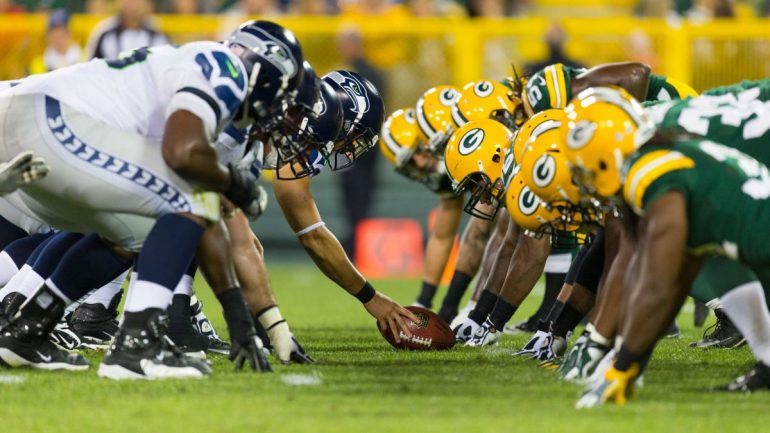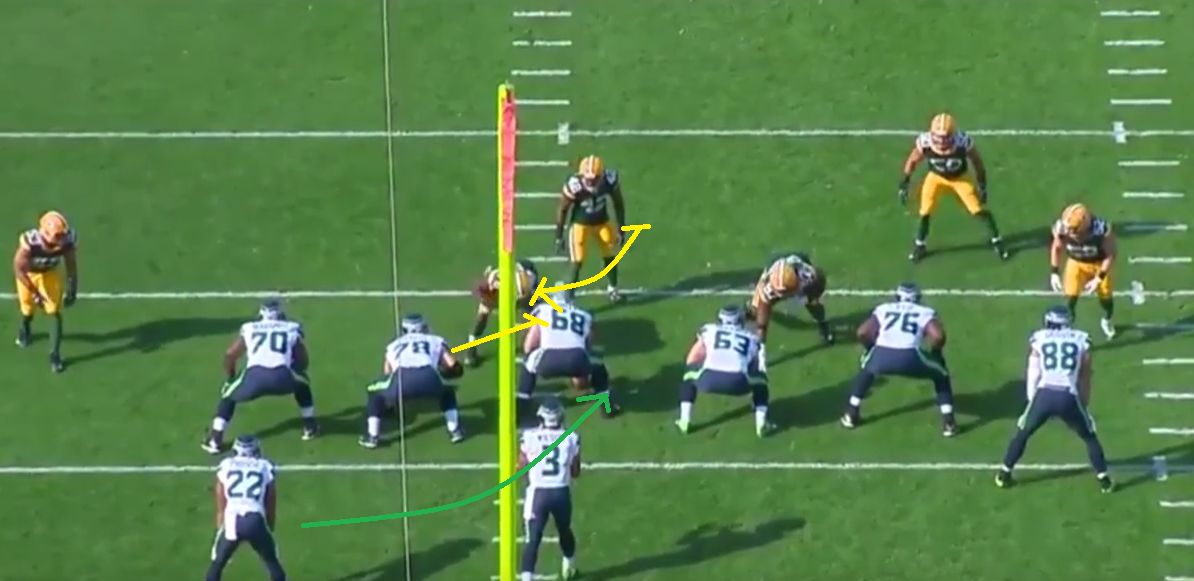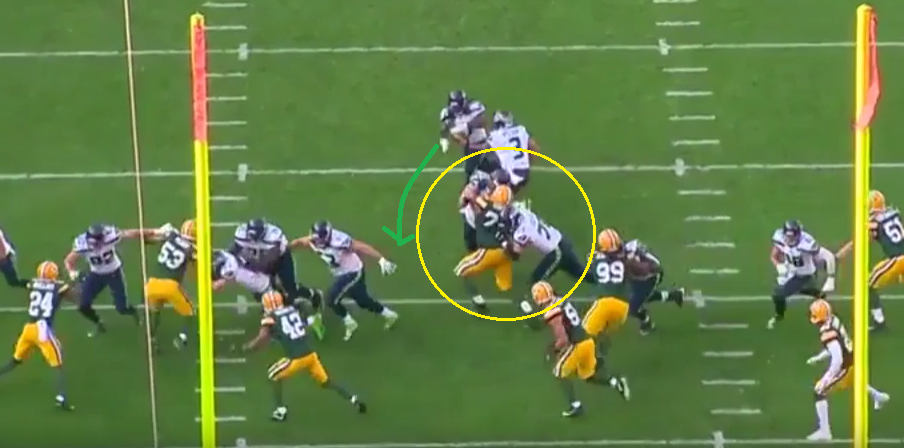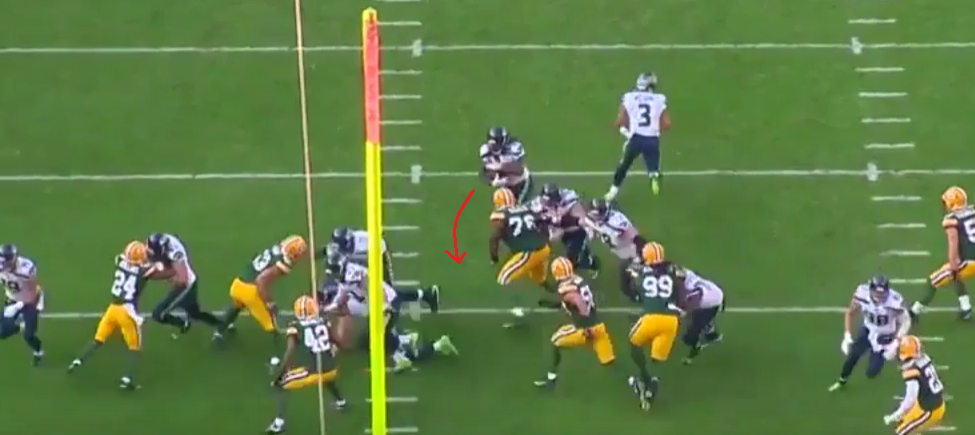One of the most fundamental components of a zone blocking scheme is the combo block. Zone blocking, for the uninitiated, is essentially a set of rules that offensive lineman use to decide who will be responsible for blocking a defensive lineman, and who will help on a double team before releasing to the second level. Here’s a diagram: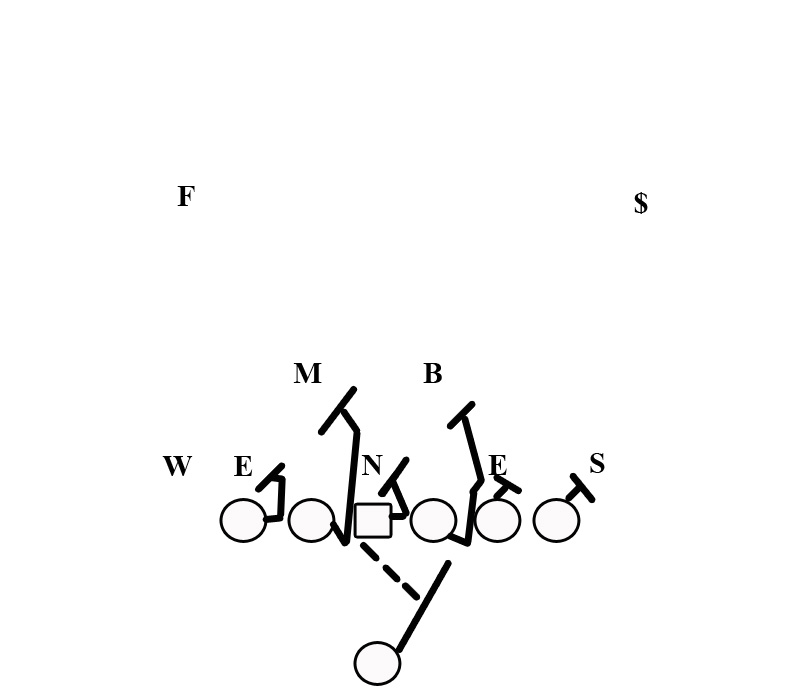
In this example, the LT, C, and RT are all “covered”, which means they have a defender lined up directly across from them. That leaves the LG, RG, and TE as “uncovered”. You can see that the covered linemen block the defender across from them, while the uncovered linemen work with the nearest covered linemen to perform a double team. The uncovered blockers are expected to help the covered linemen long enough that they’re able to at least establish their blocks, and hopefully help drive the defenders back, before peeling off an picking up a linebacker in the second level. If you’re interested, you can read more here.
Here’s an example of an outside zone play in action:
The LT (72) and LG (70) on the play execute the combo block on this outside zone run really well. The LT is ultimately responsible for getting out to the middle linebacker who is shaded off his left tackle, right where the run is headed. But before he can get out to the second level he has to help his LG, who is responsible for the defensive end. Without help, this would be a nearly impossible block for the guard to make. But the LT is patient and stays with the end long enough to stretch the play out and allow the guard to continue to drive the end out of the play.
This is a very typical play for a zone blocking system. Otherwise impossible assignments are made possible through teamwork. It should come as no surprise then that, when this coordination breaks down, a zone blocking system crumbles. Against Green Bay, Seattle demonstrated exactly that.
It’s rare to see Seattle’s offensive line hold a combo block for as long as it’s held in the example above. Frequently, the combo block hardly happens at all.
On this play, Joeckel ends up with a very tough assignment. He has to get across the defensive tackle to the playside, with the Prosise targeting the A gap between Britt and Glow.
To help Joeckel make this play, Britt needs to combo block with Luke and hold the defensive tackle long enough for Joeckel to establish his block. Britt offers little help though, offering a weak punch that is slapped away before releasing to the second level. Prosise probably needs to read this sooner and cut back, but Joeckel is blown so far into the backfield that Jimmy isn’t able to get across the formation and the weakside LB is left unblocked.
Here’s another example, this time with Glow offering next to no help to Ifedi (and whiffing in the second level for good measure).
More frequently, Seattle has the opposite problem.
Here, Britt is the covered defender with Joeckel looking to come in and help get push on the defensive tackle. Joeckel certainly lands a good push, but it does far more harm than good.
Joeckel pushes the defensive tackle off of Britt’s block and right into the hole as Lacy is looking to hit it. He does the defensive tackle’s job for him, and the play is blown up in the backfield.
What’s interesting about this is that Joeckel, before coming to Seattle, displayed the kind of patience required to make combo blocks work.
Joeckel is very patient on this double, something you don't see from Seattle OL. Will be interesting to see if that changes. pic.twitter.com/HqBidV3Len
— Nathan (@NathanE11) March 10, 2017
On this play, Joeckel pushes the defensive tackle right into the left tackle and then stays with the tackle on the block. He keeps his shoulder on the tackle to seal the hole to his right, before finally peeling out and picking up the linebacker. The situation is different in that clip though, here is one more similar to the previous play:
Patient combo blocks pic.twitter.com/Zayof0MDK4
— Nathan (@NathanE11) January 11, 2017
That play is from the Wildcard game last season, when Thomas Rawls rushed for 161 yards. Britt, Glowinski, and Fant all execute their combo blocks perfectly. Britt and Fant generate push without dislodging the defender, and Glow holds his block long enough for Fant to drive the end right out of the play.
It’s incredibly disappointing to see Seattle struggle with such fundamental aspects of their scheme. These kinds of basic issues are why I believe that Tom Cable needs to be replaced as offensive line coach. It’s especially concerning that early returns indicate Joeckel’s play may have regressed in this area. However, for those searching for reasons to be optimistic, the Detroit game from last year shows that Seattle is capable of executing these blocks. With more time together, the line might learn to work better with each other. But it’s fair to have expected these kinds of issues to be ironed out in training camp and the preseason. It’s unfortunate that this is where the offensive line’s technique is at entering week two.
